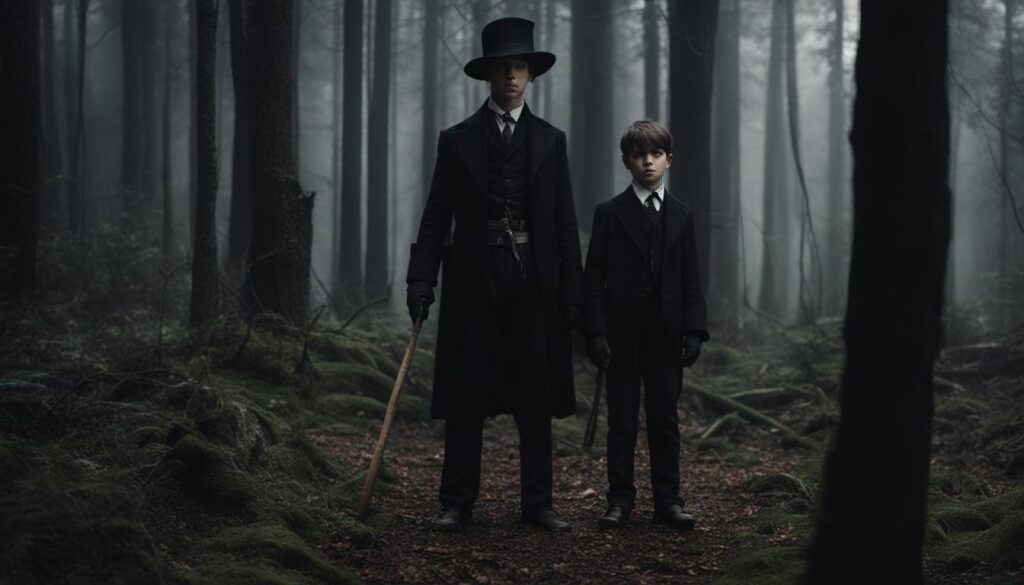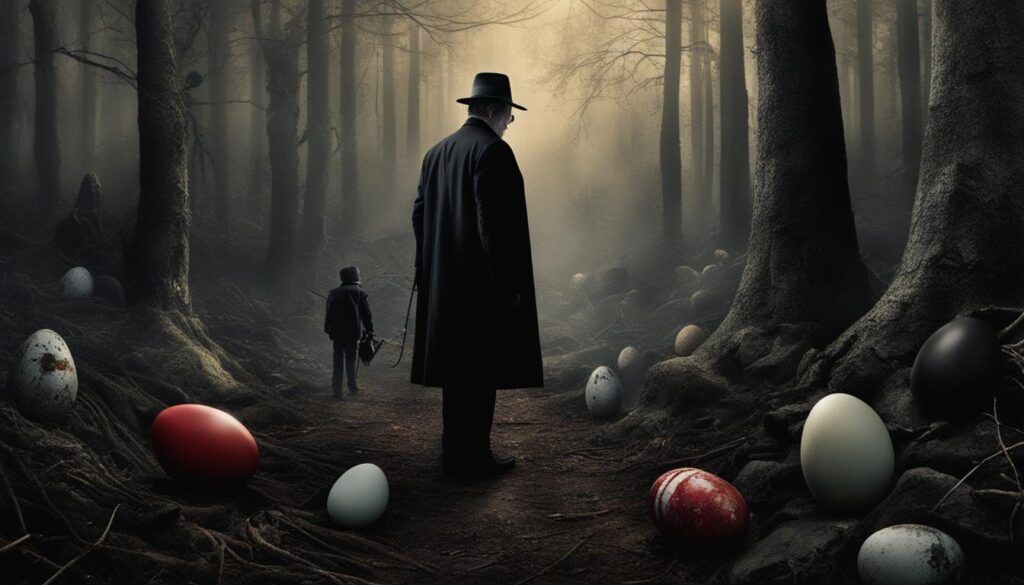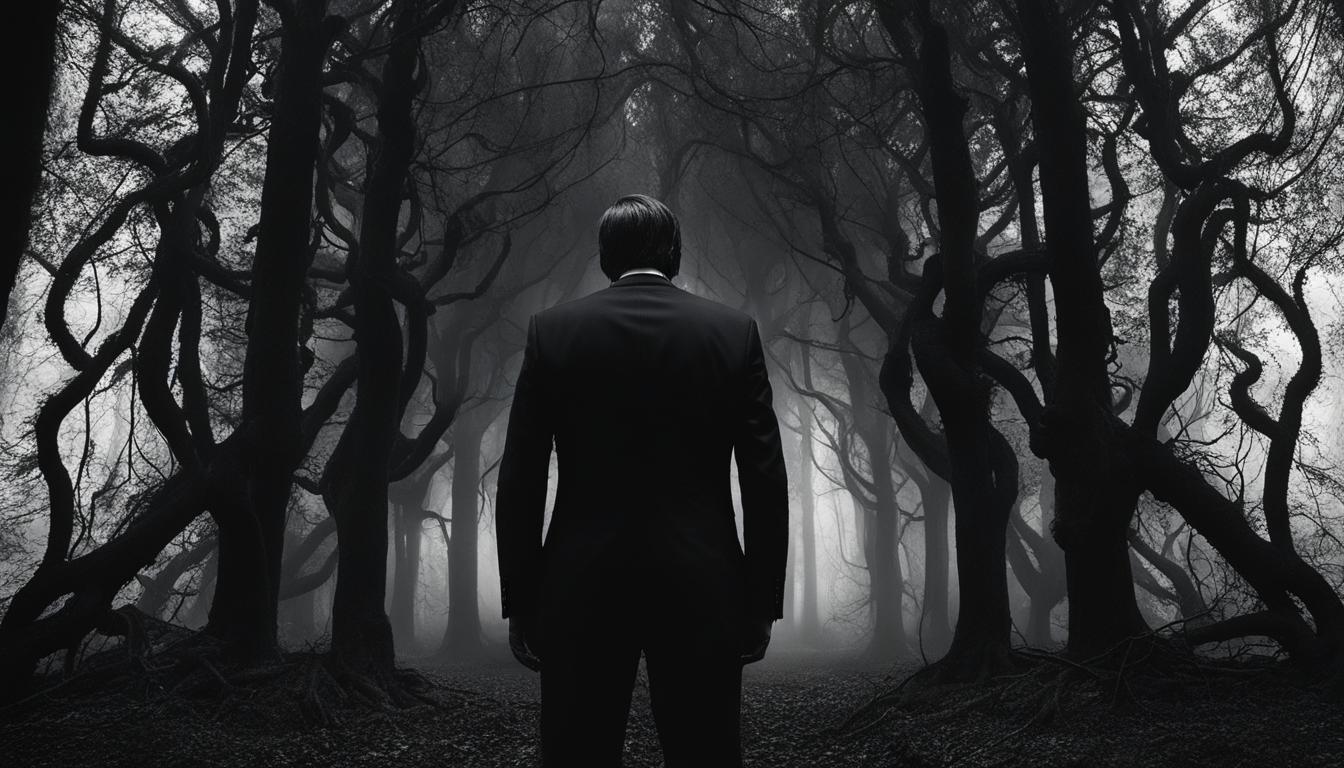Welcome to our comprehensive guide to Stephen King’s haunting short story, “The Man in the Black Suit.” In this guide, we will take you on a journey through the origins, plot, characters, and themes of this bone-chilling tale. We will also explore the literary techniques employed by Stephen King and the critical reception of the story. Additionally, we will delve into the connections to Stephen King’s larger body of work and the impact of the story on the horror genre.
Prepare to be immersed in the eerie atmosphere of “The Man in the Black Suit,” where nothing is as it seems and every page brings a new level of terror. Before we dive into the story, take a moment to admire the haunting image below, which perfectly captures the essence of the story.
Introduction to Stephen King’s “The Man in the Black Suit”
Stephen King is renowned for his captivating novels and spellbinding short stories, and “The Man in the Black Suit” is no exception. This bone-chilling tale was first published in The New Yorker in 1994 and later included in King’s “Everything’s Eventual” short story collection.
The story’s origins can be traced back to King’s youth, where he spent time exploring the woods of his home state of Maine. The dark forests and eerie atmosphere served as inspirations for many of his stories, including “The Man in the Black Suit.”
The short story follows the protagonist, Gary, as he recounts his encounter with a mysterious figure clad in black. Set against the backdrop of rural Maine in the 1920s, the story weaves a tale of fear, paranoia, and the supernatural.
“The Man in the Black Suit” is a haunting exploration of the boundaries between reality and the unknown, and a testament to King’s mastery of the horror genre.
Plot Summary
Stephen King’s “The Man in the Black Suit” is a chilling tale of a young boy named Gary who encounters a mysterious figure in the woods. The story is set in rural New England in the early 20th century, where Gary spends his days fishing and exploring his surroundings. However, one day while fishing, he has a near-death experience when he is bitten by a venomous snake. During his recovery, Gary encounters the titular Man in the Black Suit, who claims to be the Devil himself.
The Man recounts several disturbing tales of his encounters with other people throughout history before revealing his true intentions towards Gary. The Man insists that he is going to take Gary’s soul to Hell as a reward for being the first person to hear his stories in many years. Gary tries to resist the Devil’s persuasion, but his will is challenged by his own fear and the stories he has been told.
The Climax
Finally, the Devil brings Gary to the edge of a cliff overlooking a river, and the two stand there for a while. The Devil explains how Gary is going to agree to give him his soul, or he is going to push him off the edge of the cliff, making it look like an accident. At this crucial moment, Gary realizes that he no longer fears death and decides to take his chances by jumping into the river below.
The Conclusion
After swimming to safety, Gary triumphantly realizes that he has freed himself from the Devil’s clutches. The story ends with a paradoxical but hopeful message about the nature of good and evil in the world, leaving readers in suspense and deep thought about the story’s main themes.
Main Characters
“The Man in the Black Suit” features three main characters, the protagonist Gary, the antagonist The Devil, and Old Lady Bailey, a minor character. Gary, the central character, is a young boy who has a typical happy-go-lucky childhood until a fateful encounter with The Devil. The Devil is depicted as an embodiment of evil, dressed in a black suit and bearing a striking resemblance to Gary’s deceased father. Old Lady Bailey, a neighbor, helps Gary understand the implications of his experience and provides insight into the folklore of the area.

| Character Name | Role |
|---|---|
| Gary | Protagonist, Narrator |
| The Devil | Antagonist, embodiment of evil |
| Old Lady Bailey | Neighbor, provides insight into the folklore |
The contrast between good and evil is a timeless thematic element in literature. In “The Man in the Black Suit,” Stephen King utilizes the characters of Gary and The Devil to create starkly juxtaposed representations of good and evil. Gary’s innocence and naivety render him defenseless to The Devil’s malevolent intentions, while The Devil’s cunning and malevolence make him the perfect portrayal of evil.
Setting Analysis
Stephen King’s “The Man in the Black Suit” is set in rural Maine, a location often used in his stories. The dark and foreboding atmosphere of the story is greatly enhanced by the picturesque but sinister surroundings. The dense woods and open fields that surround the protagonist add to the sense of isolation and danger he feels. The location also serves to heighten the fear and tension of the story, as the Man in the Black Suit seems to come from the very heart of these woods.
The setting is masterfully crafted, and every little detail adds to the overall atmosphere of unease. The way the sunlight filters through the trees to create an eerie glow, the sound of the streams trickling through the underbrush, and the rustling of the leaves in the wind all contribute to the feeling of dread that permeates the story. Even insignificant details become meaningful, such as the flowers given to the protagonist by his mother, which later become a symbol of his innocence.
Overall, the setting is an integral part of the story, creating a sense of foreboding and fear that would not be possible without the detailed descriptions of the landscape and atmosphere that Stephen King provides.
Themes Explored
The Man in the Black Suit presents several deep and thought-provoking themes that address the complex aspects of the human experience. At its core, the story weaves together themes of darkness and evil, death and mortality, and the role of fear and courage in shaping our perceptions of reality.
With his vivid descriptions and masterful storytelling, Stephen King explores how fear can impact our lives, and how we must confront our deepest fears to grow and overcome adversity. The story’s main themes are amplified through the use of powerful imagery and metaphorical language that elevates the narrative to a higher level of depth and complexity.
One recurring existential theme in the story is the inevitability of death and our mortality as humans. Through the eyes of the protagonist Gary, King delves into the fear of death and how it shapes our outlook on life. The fear of the unknown and the great beyond is a universal experience, and the author masterfully captures the essence of this fear in the story.
Another central theme explored in The Man in the Black Suit is the idea of evil and darkness. Through the character of the titular figure, King portrays the idea that evil is a pervasive force present in every aspect of life. The author highlights the ways in which darkness and malevolence can manifest in various forms, and how it can linger and haunt us long after the initial encounter.
Themes in The Man in the Black Suit
| Theme | Description |
|---|---|
| Fear and terror | The story explores the impact of fear on the human consciousness and how it can shape our perceptions of reality. |
| Mortality and death | The fear of death and the unknown is a central theme in the story, with the protagonist grappling with existential questions about the nature of mortality. |
| Malevolence and darkness | The idea of evil as a pervasive force that lingers in the world is explored through the character of the man in the black suit. |
The themes explored in The Man in the Black Suit are universal and continue to resonate with readers, reinforcing the timeless and enduring nature of Stephen King’s storytelling. Whether it’s the fear of the unknown or the struggle with our own mortality, the story remains a thought-provoking exploration of the human psyche and the obstacles we must overcome to find light amidst the darkness.
Symbolism and Imagery
In “The Man in the Black Suit,” Stephen King masterfully employs symbolism and vivid imagery to add depth and meaning to the story. Through his use of metaphors and other literary devices, King creates a haunting atmosphere that keeps readers on the edge of their seats.
One of the most significant symbols in the story is the devil figure, embodied by the man in the black suit. The devil is a recurring theme throughout the story, and the black suit is often used to represent his presence. Additionally, the character of the devil is constantly referenced through various allusions, making his symbolic presence even more pronounced.
King also uses nature imagery to add to the sense of foreboding and danger within the story. References to poisonous plants and animals further reinforce the idea of a malevolent presence lurking behind every corner.
The story’s use of colors is also symbolic, with the color black used to represent evil and the color green used to symbolize innocence and purity. This contrast highlights the themes of sin and redemption that underlie “The Man in the Black Suit.”
The power of King’s symbolism and imagery is on full display in “The Man in the Black Suit.” His use of metaphors and other literary devices help to create a layered and nuanced story that leaves a lasting impression on readers long after the final page is turned.
Literary Analysis
Stephen King is renowned for his masterful use of literary techniques to craft compelling stories that leave a lasting impact on readers. In “The Man in the Black Suit,” King employs a range of techniques to heighten the narrative’s intensity and showcase his skilled writing style.
One notably effective technique is the use of imagery, particularly in the portrayal of the titular character. The Man in the Black Suit is depicted in vivid detail, with his thin frame, sharp suit, and glowing eyes creating an eerie and unforgettable image in the reader’s mind. Additionally, King’s use of metaphors underscores the theme of temptation presented in the story, with the trout symbolizing innocence and the devilish character tempting the protagonist to abandon his purity.
The use of symbolism is also prevalent in “The Man in the Black Suit,” most notably seen in the repetition of the color black, symbolizing death and evil. The dark forest and blackened sky serve to heighten the ominous atmosphere of the story and create a sense of foreboding for the reader.
Furthermore, King’s writing style in “The Man in the Black Suit” is marked by his signature attention to detail and his ability to skillfully create suspense. The slow and deliberate build-up of tension throughout the story effectively keeps the reader on edge and invested in the outcome.
Overall, Stephen King’s use of literary techniques in “The Man in the Black Suit” demonstrates his mastery of the craft and showcases his ability to create a haunting and unforgettable narrative.
Reception and Critical Response
Since its publication in 1994, “The Man in the Black Suit” has received critical acclaim for its haunting themes, vivid setting, and suspenseful plot. The story was included in the prestigious anthology, The Best American Short Stories 1995, which highlights exemplary works of literature published in the United States.
Critics have praised Stephen King’s masterful use of language and his ability to build tension throughout the story. In particular, the story’s portrayal of evil and its impact on the human psyche has been analyzed by literary critics and scholars.
However, there have also been criticisms of the story’s pacing and ending resolution, with some readers feeling unsatisfied by the story’s conclusion. Despite this, “The Man in the Black Suit” remains a standout work of Stephen King’s career, and continues to be studied and analyzed by readers and scholars alike.
Connections to Stephen King’s Universe
Stephen King’s works often exist within a shared multiverse, where characters, locations, and events interconnect. “The Man in the Black Suit” is no exception, featuring several references and allusions to other works within King’s body of writing.
One notable connection is to the novel “IT,” which also takes place in the fictional town of Derry, Maine. In “The Man in the Black Suit,” our protagonist encounters a balloon with the phrase “I love Derry” written on it, calling back to the infamous red balloons of Pennywise the Clown.
Additionally, the dark figure of the man in the black suit has appeared in other Stephen King stories, including “Everything’s Eventual” and “The Dark Tower” series. These intertextual references add depth and complexity to the overall tapestry of King’s writing, creating a sense of shared history and mythology among his works.

Connections to Other Works
| Work | Connection |
|---|---|
| “IT” | The use of balloons and the town of Derry |
| “Everything’s Eventual” | The appearance of the man in the black suit |
| “The Dark Tower” | The appearance of the man in the black suit |
In conclusion, the interconnectivity of Stephen King’s multiverse adds richness and depth to his works, as well as offering readers the opportunity to discover hidden connections and Easter eggs. “The Man in the Black Suit” is just one piece of this larger puzzle, inviting readers to explore the vast and interconnected universe of Stephen King.
Impact and Legacy
Since its publication in 1994, “The Man in the Black Suit” has left an indelible mark on the horror genre, cementing Stephen King’s position as a master storyteller. The story’s haunting atmosphere, vivid imagery, and powerful themes have influenced generations of writers and readers alike, inspiring countless adaptations and creative works.
With its exploration of the themes of evil, sin, and redemption, “The Man in the Black Suit” exemplifies King’s ability to tackle complex topics while still delivering a thrilling, suspenseful narrative. The story’s clever use of symbolism and metaphor has also made it a favorite among literary analysts and scholars.
Perhaps most notably, “The Man in the Black Suit” is a testament to King’s literary prowess. The story’s concise, impactful writing style showcases King’s ability to pack a punch with just a few carefully chosen words, earning him critical acclaim and a devoted fan base.
With its lasting legacy, it’s clear that “The Man in the Black Suit” will continue to captivate and inspire readers for generations to come.
Conclusion
Stephen King’s “The Man in the Black Suit” is a masterful work of horror fiction that explores the depths of fear, morality, and the power of storytelling. Through its haunting plot, vivid characters, and atmospheric setting, King weaves a chilling tale that continues to captivate readers to this day.
Our guide has taken you on a journey through the origins and significance of the story and delved into its key themes, characters, and literary techniques. We have explored the reception and critical response to “The Man in the Black Suit” and its connections to Stephen King’s larger multiverse. And finally, we have examined the lasting impact of this seminal work on horror literature and King’s own legacy.
Whether you are a lifelong fan of Stephen King or a newcomer to his work, “The Man in the Black Suit” remains a must-read for horror aficionados everywhere.



